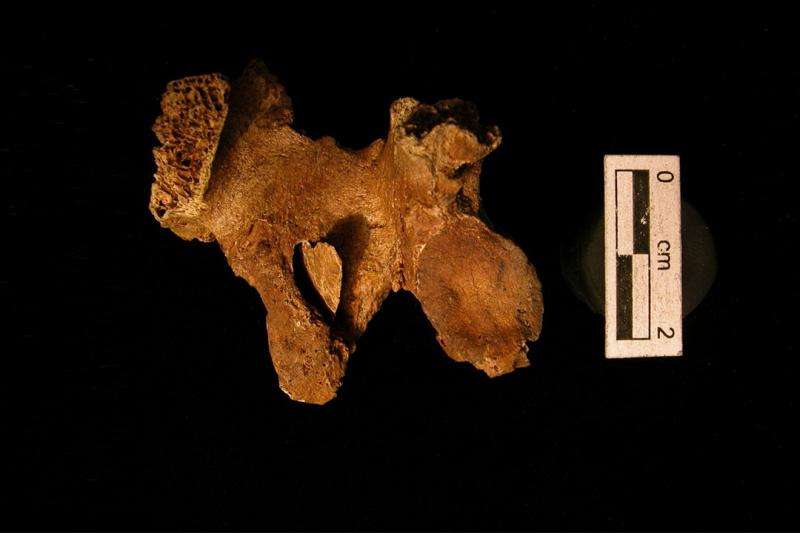Ancient spinal injury—a story of survival

It was a single fragment of bone, but to Angela Lieverse, it told an 8,000-year-old tale of violence and compassion.
In the latest issue of the International Journal of Osteoarchaeology, Lieverse and her co-authors reported a pre-modern medical miracle: the first recorded archaeological case of an individual surviving a penetrating spinal injury.
"This injury would be pretty much a death sentence if it happened today and you couldn't get to a hospital," said Lieverse, a faculty member and head of the Department of Archaeology and Anthropology in the College of Arts and Science. "So if we go back in time 8,000 years, which is when this individual lived, it's nothing short of remarkable that he didn't die immediately."
During a recent trip to Russia, Lieverse encountered a piece of a vertebra from the lower back of a 25-to-35-year-old man, a member of an Early Neolithic hunter-gatherer community in what is now Siberia. Along with the rest of the man's incomplete remains, it had been excavated years earlier from an ancient cemetery by one of Lieverse's collaborators from Irkutsk State University in Russia.
Embedded deep within the vertebra was a stone arrowhead. The man, it seemed, had been shot in the back while fleeing an assailant.
Similar injuries have been documented in the past by archaeologists, but incredibly, the bone in this case had almost entirely healed around the projectile. Lieverse, who specializes in human remains, recognized the significance immediately: this individual must have survived for months after his cata- strophic injury.
The bone was shipped to the University of Saskatchewan, where Lieverse brought it to David Cooper, Canada Research Chair in Synchrotron Bone Imaging and a faculty member in the College of Medicine's Department of Anatomy and Cell Biology. Cooper performed micro-computed tomography (micro-CT) imaging on the fragment.
"With the micro-CT we were able to look deeply into the bone and see how it had healed and remodeled around the projectile point," said Lieverse.

They concluded that the owner of the vertebra had survived for a year or even longer after his injury.
The healing process would not have been easy. Damage to this part of the spinal cord would not have paralyzed the victim, but he must have suffered persistent pain, weakness and infection. He would also have required extensive care, both immediate and long-term, noted Lieverse.
"That's really interesting, too," Lieverse said. "It shows remarkable evidence of compassion by his community members to keep him alive and fed and to get him to safety after the injury."
That compassion extended beyond his death. When the man eventually died—whether from complications from his injury or from an unrelated cause is impossible to say—he was buried no differently than the other members of his community. He was placed on his back, his head facing west, and richly surrounded with tools and ornaments.
"It shows that he was not given any particularly different status because of his injury," Lieverse said. "He was buried for who he had been his whole life and not for the possibly disabled person he may have been in that last year."
The archaeologist believes it is a case that challenges the simplistic views some of us have about pre-modern people.
"I think it tells you that people were valued even in the distant past for lots of things, not just their physical prowess, or their reproductive ability or whatever you might think," said Lieverse. "It's quite a lot more nuanced than that."
More information: A. R. Lieverse et al. Penetrating Spinal Injury: An Extraordinary Case of Survival in Early Neolithic Siberia, International Journal of Osteoarchaeology (2016). DOI: 10.1002/oa.2568

















